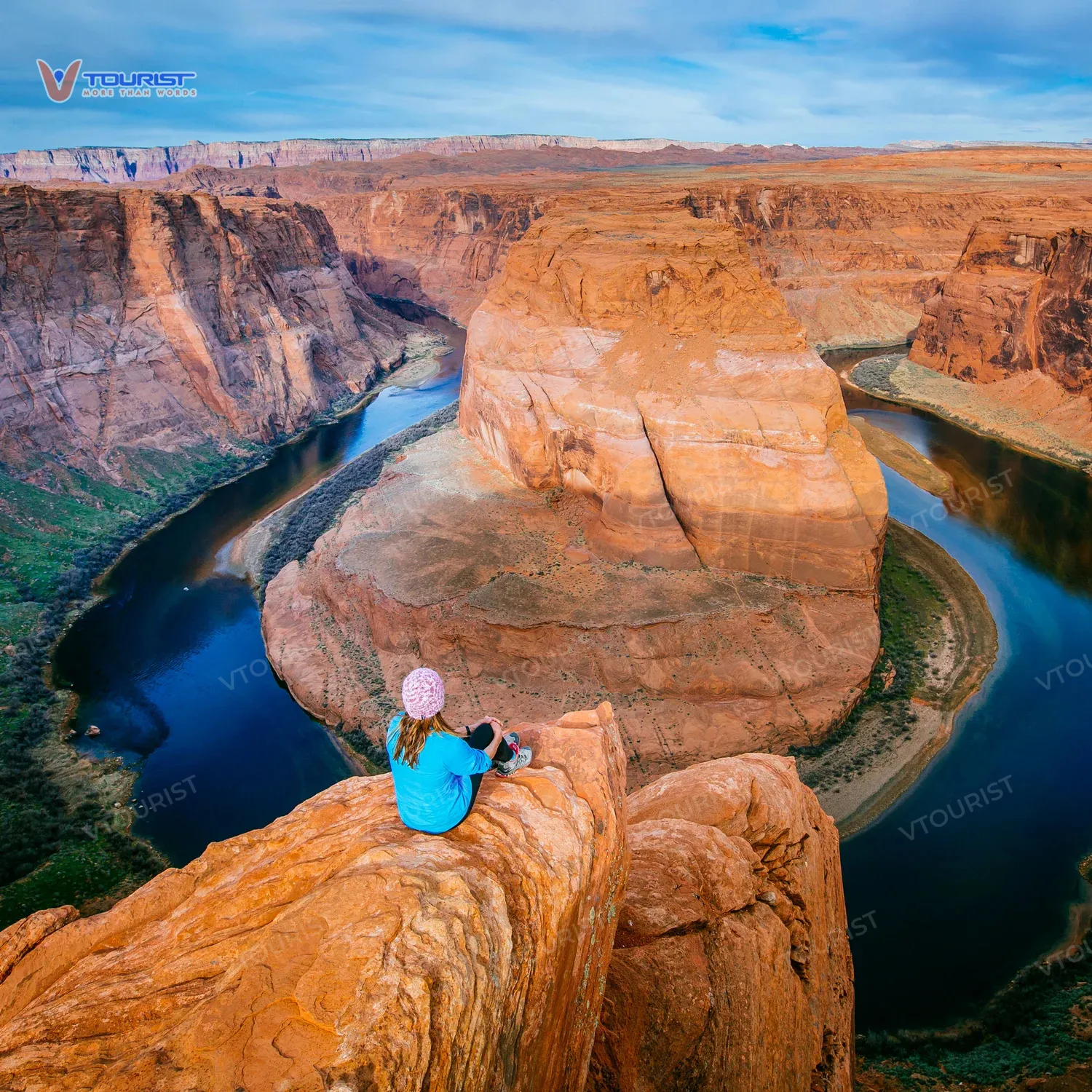Arizona, famed for the majestic Grand Canyon, also harbors a collection of bizarre and unique landscapes that evoke the feeling of stepping onto another planet. From vibrant sandstone canyons to vast deserts dotted with strange geological formations, Arizona is an unmissable destination for those passionate about discovering nature’s unparalleled beauty.
Horseshoe Bend – The Magnificent U-Shaped Bend
Horseshoe Bend, a truly breathtaking natural wonder in Arizona, showcases the Colorado River’s power as it meanders and carves through sandstone over millions of years, creating a perfect horseshoe shape.

Standing on the cliff edge nearly 1,000 feet above, visitors can marvel at the panoramic view of Horseshoe Bend. The turquoise river sharply contrasts with the reddish-orange sandstone, a spectacle that easily conjures images of a distant planet with strange rivers flowing through red rock canyons.
The Miraculous Formation
Horseshoe Bend’s distinctive horseshoe shape is the result of millions of years of erosion by the Colorado River. Over time, the river eroded and cut deep into the Navajo sandstone, forming an almost perfect meander.
The vibrant red sandstone layers owe their color to minerals like iron oxide, giving Horseshoe Bend its characteristic hue. This color shifts throughout the day, from a bright orange in the morning to a deep red in the afternoon, offering diverse visual experiences for visitors.
Ideal Visiting Times
Horseshoe Bend is most stunning at sunrise and sunset when the angled sunlight accentuates the colors and shapes of the canyon. However, these are also the most crowded times, so arriving early is recommended to secure the best viewing spot.
During the day, the intense sunlight might reduce color contrast, but the grandeur of Horseshoe Bend remains impressive. Photographers should be prepared to capture breathtaking shots of this natural marvel.
Antelope Canyon – The Canyon of Light
Antelope Canyon, a narrow slot canyon celebrated for its mesmerizing light beams and unique rock formations, is a masterpiece of nature sculpted by water and wind erosion on Navajo sandstone.

When sunlight penetrates the canyon, it creates ethereal light shafts, highlighting the textures and unique forms of the rock. The rock colors also transform throughout the day, ranging from vibrant oranges to mystical purples.
The Two Sections of Antelope Canyon
Antelope Canyon is composed of two main sections: Upper Antelope Canyon and Lower Antelope Canyon.
- Upper Antelope Canyon: Renowned for the most spectacular light beams, it’s more easily accessible and suitable for all ages.
- Lower Antelope Canyon: Narrower and steeper than Upper Antelope Canyon, it requires navigating stairs and rock crevices. However, Lower Antelope Canyon offers a more adventurous and less crowded experience.
Tips for Visiting Antelope Canyon
To maximize your Antelope Canyon experience, booking a tour in advance is highly recommended, especially during peak season. Be prepared to walk in low-light conditions and bring a camera to capture the stunning moments.
Bisti/De-Na-Zin Wilderness – The Strange Wilderness
Bisti/De-Na-Zin Wilderness, situated in northwestern New Mexico near the Arizona border, is famed for its bizarre geological formations sculpted by water and wind erosion on sedimentary rock.

The rock formations in Bisti/De-Na-Zin Wilderness vary greatly, from towering hoodoos to peculiar mushroom-shaped rocks. The rock colors are also diverse, ranging from pale grays to vibrant reddish-oranges.
Another Planet Right Here on Earth
Stepping into Bisti/De-Na-Zin Wilderness feels like entering another planet. The wild and strange landscapes evoke scenes from science fiction movies.
Exploring Bisti/De-Na-Zin Wilderness requires thorough physical preparation and equipment, as the area lacks marked trails and support services. Bring ample water, food, and maps to ensure a safe trip.
White Pocket – The Mysterious White Pocket
White Pocket, a small area in northern Arizona near the Utah border, is famous for its unique white sandstone formations sculpted by water and wind erosion.

The rock formations in White Pocket exhibit soft, undulating shapes, creating a surreal landscape. The white rock contrasts sharply with the surrounding reddish-orange sandstone, crafting a breathtaking panorama.
Exploring White Pocket
White Pocket is a lesser-known destination, allowing visitors to enjoy tranquility and privacy while exploring. However, reaching White Pocket requires a four-wheel-drive vehicle and experience driving on rough terrain.
Prepare for a challenging adventure, but you will be rewarded with the unique beauty of White Pocket.
Conclusion
Arizona is more than just arid deserts and grand canyons. It conceals bizarre and unique landscapes that make visitors feel as though they’ve journeyed to another planet. From Horseshoe Bend to Antelope Canyon, from Bisti/De-Na-Zin Wilderness to White Pocket, Arizona is an unmissable destination for those passionate about exploring nature’s unparalleled and otherworldly beauty. Plan your trip today and discover these extraordinary “planets”!